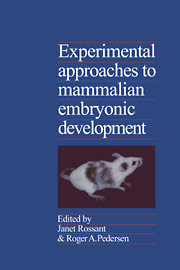Book contents
- Frontmatter
- Contents
- Preface
- Contributors
- Cellular aspects
- 1 Potency, lineage, and allocation in preimplantation mouse embryos
- 2 Time and space in the mouse early embryo: a cell biological approach to cell diversification
- 3 Comparative aspects of embryo manipulation in mammals
- 4 Development of extraembryonic cell lineages in the mouse embryo
- 5 Analysis of tissue fate and prospective potency in the egg cylinder
- Molecular and biochemical aspects
- Toward a genetic understanding of development
- Index
4 - Development of extraembryonic cell lineages in the mouse embryo
from Cellular aspects
Published online by Cambridge University Press: 31 March 2010
- Frontmatter
- Contents
- Preface
- Contributors
- Cellular aspects
- 1 Potency, lineage, and allocation in preimplantation mouse embryos
- 2 Time and space in the mouse early embryo: a cell biological approach to cell diversification
- 3 Comparative aspects of embryo manipulation in mammals
- 4 Development of extraembryonic cell lineages in the mouse embryo
- 5 Analysis of tissue fate and prospective potency in the egg cylinder
- Molecular and biochemical aspects
- Toward a genetic understanding of development
- Index
Summary
Introduction
Cell lineage analysis has been a particularly valuable approach for understanding the relationship between cell fate and cell determination in a variety of species. In some invertebrates, such as Caenorhabditis elegans and the leech, a combination of visual observation and injected lineage tracers has allowed the fate of every cell in the embryo to be followed through development (Sulston et al. 1983; Weisblat and Blair 1984). These studies have shown that lineage is almost invariant in such species; a rigid pattern of cell division generates a distinct set of progeny of defined cell fate. This in variance is associated with fairly rigid cell determination. Although cell-cell interactions may affect cell fate in some stages of lineage development (Sulston et al. 1983; Weisblat, Kim, and Stent 1984; Zackson 1984), various experimental manipulations have shown that most cells of C. elegans become heritably restricted to their fate early in development (Sulston and White 1980; Kimble 1981). In other species, such as Drosophila, cell lineage cannot necessarily be defined at the single-cell level, but groups of cells, or polyclones (Crick and Lawrence 1975), are set aside early in development and give rise to discrete “compartments” in later development (Garcia-Bellido, Ripoll, and Morata 1973; Morata and Lawrence 1976). The compartment boundaries established early in embryogenesis also represent boundaries of heritable cell commitment or determination. It is important to note in all these cases that lineage determination does not necessarily imply commitment to a given cell type, but rather to a given pattern of development.
Information
- Type
- Chapter
- Information
- Experimental Approaches to Mammalian Embryonic Development , pp. 97 - 120Publisher: Cambridge University PressPrint publication year: 1987
Accessibility standard: Unknown
Why this information is here
This section outlines the accessibility features of this content - including support for screen readers, full keyboard navigation and high-contrast display options. This may not be relevant for you.Accessibility Information
- 5
- Cited by
